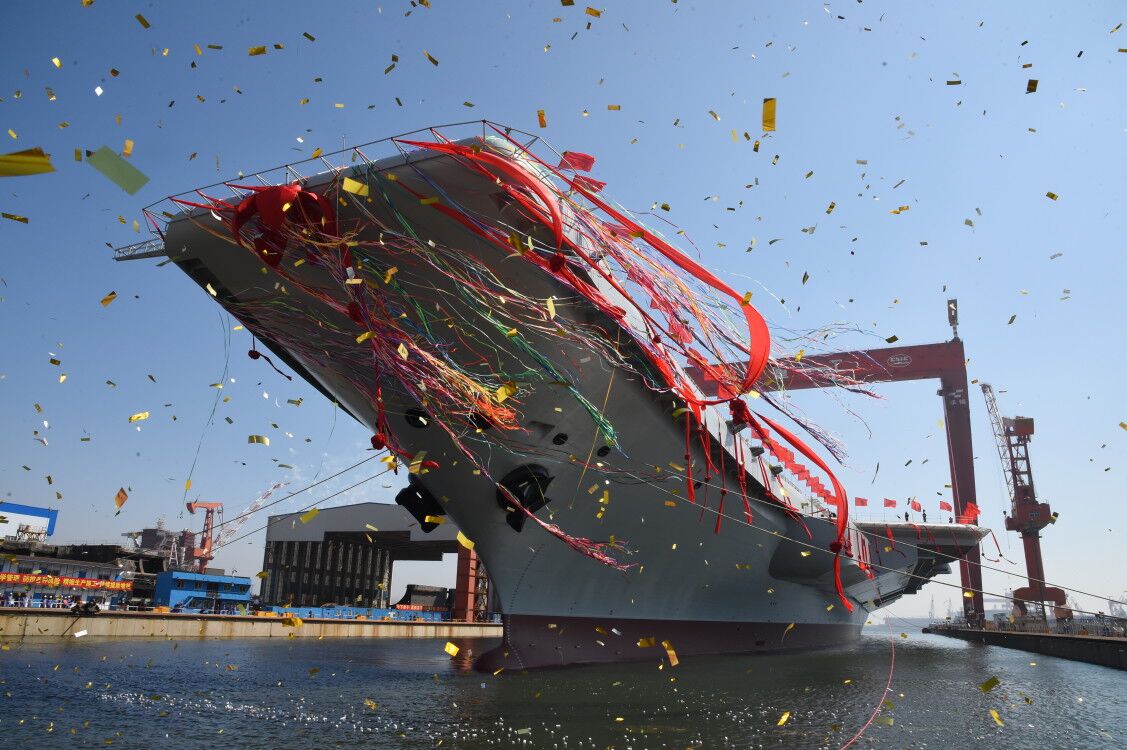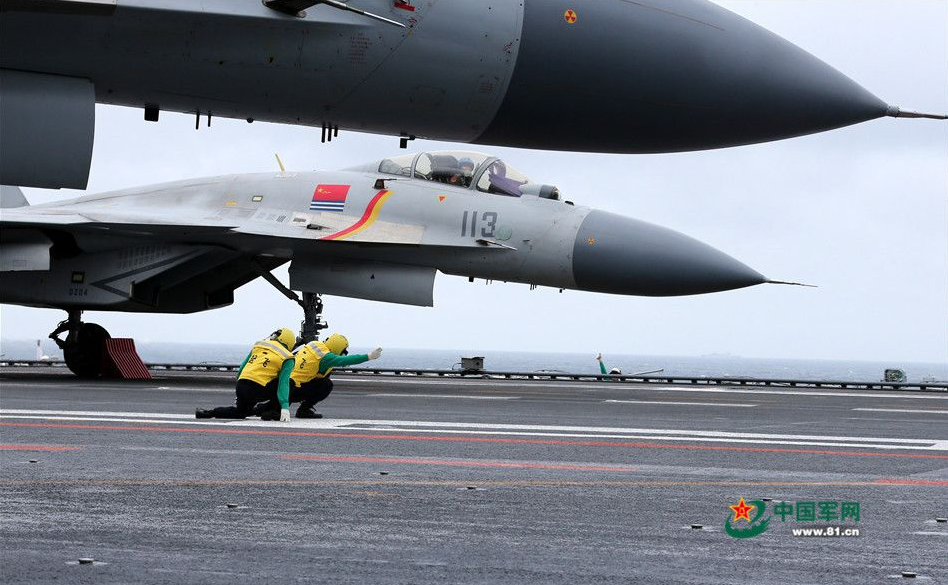
This post has been updated with additional information from naval analysyts.
China has launched its first domestically built aircraft carrier in a ceremony at a northern Chinese shipyard on Wednesday.
The 50,000-ton Type-001A carrier was launched in a flurry of ticker tape and confetti from its dry dock at the Dalian Shipyard just after 9 A.M. local time on Wednesday (9 P.M. EDT, Tuesday).
“A bottle of champagne was broken on the aircraft carrier as a customary way of blessing the ship,” read a statement from the Chinese National Ministry of Defense.
“After that, the new aircraft carrier was slowly towed out of the dockyard and transferred to the wharf.”
The Type-001A is based on the Kuznetsov-class Russian carrier Liaoning, the incomplete aircraft carrier Beijing bought in 1998, refurbished and commissioned in 2012.
According to imagery released by the People’s Liberation Army Navy, like Liaoning, the new carrier will rely on a Short Take Off But Arrested Recovery (STOBAR) system of launching aircraft with fighters launching from a so-called skip-ramp at the bow of the ship.
The new carrier was modified from the original design to include a new S-band radar system, a smaller island to maximize the number of aircraft aboard and changes to the ski-ramp launching system.
Reports from the PLA say the new carrier would field an unspecified number of Shenyang J-15 Flying Shark – an unlicensed copy of the Russian Sukhoi Su-33 fighter.
The Chinese quietly began construction of the Type-001A in 2013 at the same shipyard the Liaoning was with analysts guessing the nature of the construction through photos posted on the Chinese language internet.
In late 2015, after almost two years of speculation, Chinese officials confirmed the construction of the Type-001A in an unexpected press conference.
“After taking into account a range of factors, the relevant authorities launched work on developing a second aircraft carrier, and we are now undertaking our own indigenous design and construction,” Col. Yang Yuju, according to a translation of a Chinese language transcript of the Dec. 31 press conference.
“We have a long coastline and a broad maritime jurisdiction… Defending national maritime security, and safeguarding sovereignty over territorial seas and over maritime rights and interests, are sacred duties of China’s armed forces.”
China’s Aircraft Carrier Future

China is thought to have already begun construction on its second domestic carrier – Type-002 — at the Jiangnan Changxingdao shipyard near Shanghai.
Unlike the new Type-001A and Liaoning, the new carrier is expected to field a catapult launching system allowing a wider variety of aircraft to operate from the carrier. Satellite images of the nearby Huangdicun Airbase in Liaoning Province show what appears to be electromagnetic and steam catapult launching test systems.
“Developing its own CATOBAR system, and fitting it on China’s future aircraft carriers will enable the PLAN to operate a well-rounded carrier air wing that includes force multipliers such as Airborne Early Warning and Control aircraft, which tend to be heavier and use less-powerful, but more efficient engines,” wrote USNI News contributor Mike Yeo in September.
Still, what China intends to do with the carriers is less than clear.
“China wants to sail a gradually increasing number of aircraft carriers into the center of growing blue water operations. The evidence is growing in Chinese shipyards and ports across the Indian Ocean and beyond,” Andrew Erickson, an associate professor at the U.S. Naval War College’s China Maritime Studies Institute (CMSI) and author of a recent book on Chinese naval shipbuilding, told USNI News on Wednesday.
Beijing has flirted with transparency in expressing its aircraft carrier goals. Government documents and officials have said China was set to pursue a four-carrier force over the last eight years.
Buried in its 2010 Ocean Development Report, China declared it would pursue development of its own domestic carrier program. It took six months for the detail to make it into the Western press.
“In 2009, China put forward an idea and plan for building aircraft carriers. These indicate China has entered the historical era of building a maritime superpower,” read a translation of the report.
Three years ago, a Chinese party official declared Beijing was set to build four carriers in a state report, but the government quickly deleted the instance.
A four-carrier force would mimic traditional carrier deployment patterns in which there are three carriers in maintenance or workups for every carrier deployed.
“This is likely just the beginning of China’s fledgling naval aviation capabilities as their maritime forces build towards a large well-balanced fleet capable of protecting and projecting Chinese interests in the Pacific and potentially around the world,” Eric Wertheim, author of U.S. Naval Institute’s Combat Fleets, told USNI News on Wednesday.

The following is the complete April 26, 2017 release from the Ministry of National Defense of the People’s Republic of China.
DALIAN, April 26 (ChinaMil) — The launching ceremony of China’s second aircraft carrier was held at the Dalian Shipyard of the China Shipbuilding Industry Corporation(CSIC) on the morning of April 26, 2017. Gen. Fan Changlong, member of the political bureau of the Communist Party of China (CPC) Central Committee and vice chairman of China’s Central Military Commission (CMC) attended the ceremony and delivered a speech.
The ceremony was kicked off in magnificent national anthem at 9:00 and a bottle of champagne was broken on the aircraft carrier as a customary way of blessing the ship. After that, the new aircraft carrier was slowly towed out of the dockyard and transferred to the wharf.
The second aircraft carrier is domestically built by China. China started building it in November, 2013. At present, the main hull of this aircraft carrier has been completed and the main system devices including power supply have been installed in place.
Undocking and launching is one of the important nodes of a new aircraft carrier construction, marking that China has made significant phased achievements in designing and building an aircraft carrier independently. Next, the aircraft carrier will debug its system devices and conduct fitting-out as planned, and start mooring tests in an all-round way.
The PLA Navy Commander Shen Jinlong,PLA Navy Political Commissar Miao Hua, and CSIC President Hu Wenming also attended the ceremony.





